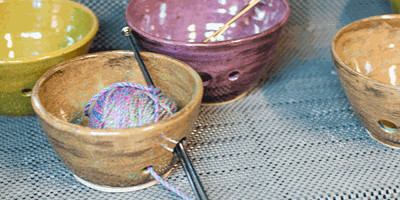Somewhere just before Eclectic on Alabama Route 14 is the aptly named unincorporated and unofficial community of Fleahop, and somewhere between Old Plank and East Fleahop roads, removed from the highway by just a few acres of land, sits an unassuming, nice-looking, house where – on a wet, cold January day – Chris McElvaine pores over her previous day’s work to determine just where to take her artistry next.
“What I get out of it is a feeling of producing something for somebody else that they like,” said McElvaine, proprietor of Fleahop Pottery.
“When somebody buys my stuff I just ear-to-ear grin because I can’t believe that somebody values what I make enough to buy it.”
Her surroundings lend themselves to McElvaine’s style, given the idyllic rural setting in which her studio is located.
From the window of her basement studio, the potter’s eye follows a sloping hill to a pond ringed with young pines. If she steps away from the spinning wheel and into her garden on stone steps that lead to a gazebo, she is enveloped in a touch of the Orient. With 21 acres, gardens, chickens and dogs, McElvaine gleans inspiration from her surroundings, which also include the wall-to-wall, floor-to-ceiling arrangement of the products of her labor.
McElvaine is not sentimental about her work – she focuses on what’s functional – but there is romance in the reasoning of her designs and their translation in clay.
Sometimes, she said, three hours would pass unnoticed as she listened to a book on tape or National Public Radio, lost with her hands at the wheel.
“When my husband told me to get a pottery wheel it was because he was afraid I was going to be bored in retirement, and I can say with all honesty I have not been bored one minute since I retired,” McElvaine said.
After her 17 years with Montgomery Eye Physicians, the doctors asked McElvaine what she wanted as a retirement gift. She’d always had an interest in pottery but had never pursued it; after talking with her husband, Cecil McElvaine, a retired Alabama state trooper, she decided to convert the basement man cave into a pottery studio.
“You have to really want to do something to do it in a cold, unheated place,” McElvaine said.
She started her retirement with a six-week class at a recreation center in Opelika. After each class, she said, she came home to the wheel in her studio.
“I worked and worked and worked.”
Cecil encouraged her every step of the way, though he later admitted that, at the time, he had no clue his wife’s interest in pottery would extend beyond a hobby and turn into a local institution and a business.
McElvaine’s interest in pottery manifested in the couple’s travels. Wherever they went, she looked for pottery.
During a recent cruise to France, she visited Rouen, a town renowned for its pottery.
Though she acknowledges an appreciation of porcelain, it is the substance of pottery itself – its heft and sturdiness – that draws her.
The clay is rather like children’s modeling clay but wetter. To throw a measured wedge and transform it into a useable, consistent shape is akin to kneading dough and requires wet hands. The water keeps her hand slipping over the mass as the clay absorbs the water.
After shaping it, McElvaine allows the object to dry in stages.
Once the clay is bone dry, she heats it in a kiln at a low temperature to turn the piece to bisque, and though the moisture has been removed at this stage and the bisque is hard, she said, it is not ʻvery hard.ʼ So next, she applies a glaze and heats it again at a higher temperature, after which her handiwork is vitrified, and vitrification is the goal.
“There’s a lot of chemistry to it,” McElvaine said.
The heavily annotated process takes days to see through from its beginning as a lump of clay to a project’s end as a pitcher, jug or knitting bowl.
“I love making casseroles,” she said, “And bowls and pitchers and jugs. I do not like making mugs, but everybody wants a coffee mug.
“I’ve never really thought of myself as an artisan. I really can’t draw a straight line. I’m not artistic; I see it as a craft, rather than an art, because I don’t feel like I have the ability to create art. What I can do is make a bowl.”
The basement man-cave-turned-potter’s-studio exceeds its expectations in humble Fleahop, Alabama.





